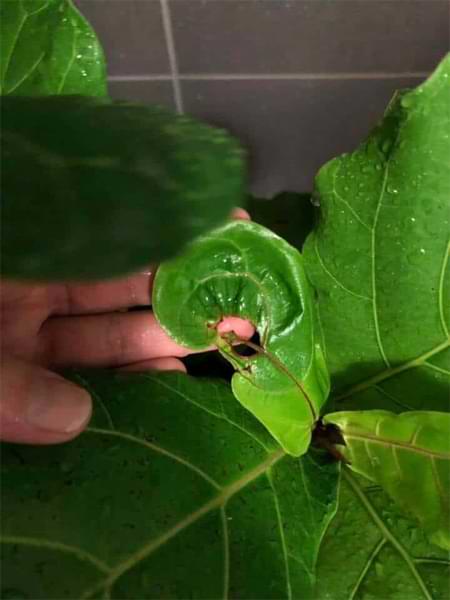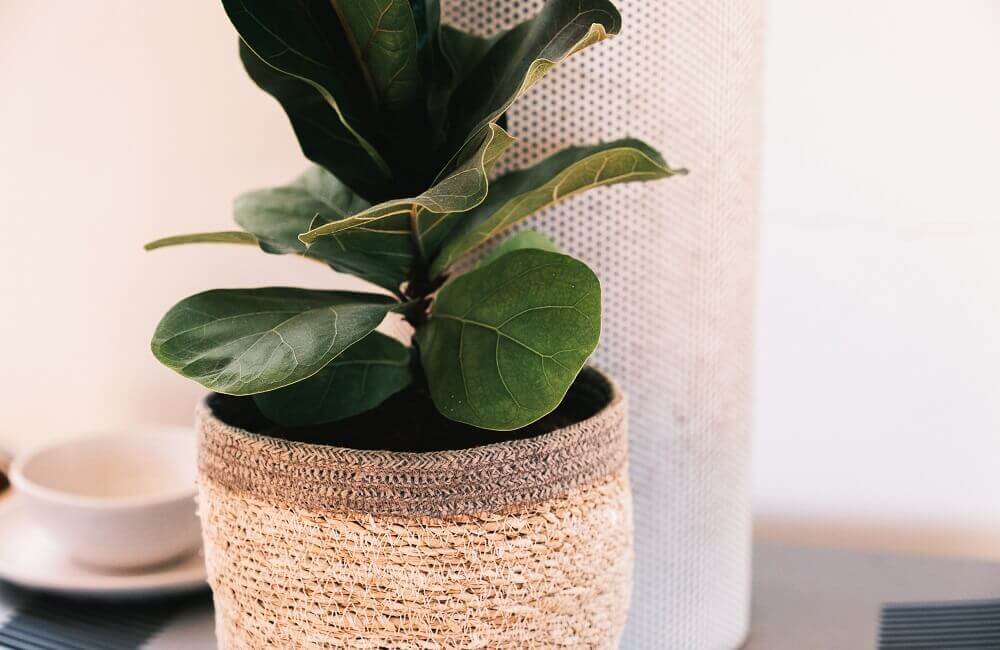You should take care of your fiddle leaf figs right away because they are great houseplants. This article will cover new leaf troubleshooting for fiddle leaf figs!.
Fiddle leaf figs are renowned for their finicky nature. If your plant seems stuck and you’re wondering “why is my fiddle leaf fig not growing?”, there are some common issues that may be at play. With a few simple adjustments to care, you can get your plant back on track and finally see those gorgeous new leaves emerge.
Below we’ll explore the most frequent reasons fiddle leaf figs stop growing along with fixes to get them thriving again:
1. Inadequate Light
Hands down, lack of sufficient light is the number one reason fiddle leaf figs fail to grow These plants need bright, indirect light to create the food energy that fuels growth via photosynthesis
A minimum of 4-6 hours of bright natural light daily is best. If your fig is more than a few feet from a sunny window, it likely needs more light. Growth will stall in darker corners or areas with only artificial lighting.
Solutions:
-
Move your plant right in front of an east, south, or west window if possible. West is ideal for providing bright afternoon sun that fiddles love
-
Rotate the plant weekly to equalize light distribution.
-
Supplement with a grow light if additional light is needed. LED grow lights work well and last for years. Position the light 6-12 inches above the plant.
-
In warmer months, placing your fiddle outside in a spot with partial shade/filtered sun can provide a growth boost.
More light equals more energy for growth. Low light is the most common fix for a fiddle leaf fig that’s not growing new leaves.
2. Underwatering
While they don’t like wet feet, fiddle leaf figs should never be allowed to dry out completely. If the soil dries too much between waterings, this drought stress will cause leaves to brown and drop. It also halts growth.
Solutions:
-
Water when the top few inches of soil become dry. For larger plants, check moisture at both the top and bottom of the pot.
-
Smaller plants need watering every 1-2 weeks while larger fiddles may need water every 4-7 days. The warmer and brighter the environment, the more frequently plants need water.
-
In winter when light and growth are reduced, scale back on watering frequency. Let soil dry out a bit more before saturating again.
-
Brown crispy leaf tips are a sign the plant needs more frequent watering. Don’t wait until leaves droop to water.
3. Overwatering
While underwatering keeps your fiddle leaf fig from growing, overwatering can be even worse. Too much moisture suffocates roots and leads to rot. Damaged roots can’t take up water and nutrients properly, resulting in poor growth.
Solutions:
-
Allow soil to dry out at least halfway down the pot before watering again. Do not water on a calendar schedule.
-
Ensure pots have drainage holes at the base. Use well-draining soil mixes, not heavy potting soil.
-
Empty water from decorative outer planters frequently so plants don’t sit in water.
-
Use your finger to gauge moisture rather than moisture meters, which can give faulty readings.
-
Cut back on watering frequency in winter and any time growth is slower.
Adjust your watering habits if you suspect overwatering is an issue. Aim for thorough soakings only after the top few inches of soil become dry. Proper moisture is key for fiddles to grow well.
4. Old, Compacted Soil
Fiddle leaf figs are sensitive to old, compacted soil that can no longer hold moisture and nutrients properly. After 2-3 years, the soil likely needs refreshing with new potting mix to facilitate growth.
Solutions:
-
Repot in fresh, well-draining soil blend every 2-3 years. This provides new nutrients and better aeration.
-
Or top dress annually with quality potting mix to refresh the soil rather than doing full repotting.
-
Ensure any potting mix contains compost or organic material. Avoid 100% peat or coconut coir mixes which compress over time.
-
When repotting, go up only 1-2 inches in pot size rather than too large to prevent soil from drying out too slowly.
Rejuvenate old soil with new potting mix so roots can access the moisture and nutrients they need to drive growth.
5. Rootbound Plant
As fiddle leaf figs grow, their roots quickly fill pots. Rootbound plants struggle because the mass of roots prevents proper moisture retention and distribution within the soil.
Solutions:
-
Carefully remove from the pot annually to check if roots are densely packed and circling the edges. This signals it’s time to size up.
-
Repot in a container that is only 2 inches wider if the plant is extremely rootbound. Too large of a pot can cause moisture issues.
-
Use a knife to gently loosen circling peripheral roots before repotting so they grow outward into the new soil.
-
After repotting, avoid fertilizing for a month while new roots establish. Then resume regular feeding.
Freeing up bound roots sustains growth rather than letting the plant become pot-locked.
6. Improper Fertilizing
Fiddles are light feeders but still need regular nutrition to fuel growth and remain healthy. Using the wrong type of fertilizer or incorrect dosing can limit their growth potential.
Solutions:
-
Fertilize lightly every 2-4 weeks in the growing season using a balanced houseplant formula. Erring on the side of less is better.
-
Seek out a fertilizer with an NPK ratio around 3-1-2, which is ideal for fiddles, rather than too much nitrogen.
-
In winter, scale back to fertilizing monthly or every 6 weeks as growth slows.
-
Always dilute any liquid fertilizer to half strength or less to avoid burning delicate roots.
-
If using time-release fertilizer granules, sprinkle lightly and reapply no more than every 3 months.
Consistent feeding with an appropriate fertilizer gives your fiddle the nutrition needed for lush growth.
7. Environmental Stress
Fiddles prefer warm, humid conditions with average home temperatures and moderate humidity. Exposure to cold drafts, dry air, or sudden environmental changes can lead to stalled growth.
Solutions:
-
Keep fiddles in an area with consistent warmer temps between 65-80°F. Avoid drafty windows and vents.
-
Run a humidifier nearby to increase humidity around the plant to 40-60%.
-
Group plants to raise humidity levels. Mist leaves occasionally to supplement humidity.
-
Move plants gradually to avoid shocking them when changing light or temperature conditions.
Monitoring conditions and avoiding abrupt changes helps minimize stress and keeps fiddles growing steadily.
The key takeaway is that fiddle leaf figs require very specific care to flourish. But now that you know the most common growth inhibitors, you can get your plant back on track!
Start with assessing where improvements can be made: light, watering, soil condition, pot size, fertilizer, or environment. Address any issues through the solutions outlined above. With a few simple tweaks, you’ll have your fiddle leaf fig growing happily again.
Holes in Your New Leaves

Baby leaves can grow out with holes when the leaves are too dry.
They can stick together or to their casings as they sprout, which can tear holes.
This is usually a sign that the air is too dry and your plant would prefer higher humidity.
Misting your fiddle leaf figs is not a good idea because it stops them from breathing and photosynthesis and can cause powdery mildew. However, you could put a humidifier in the room with your fiddle leaf fig (but don’t point it directly at the plant). Especially if you live in a dry climate. Humidity trays are also a good option.
Also, make sure that the new growth doesn’t get direct sunlight, which can also dry out the leaves.
Drying Up, Shriveling, and New Leaves Falling Off

Fiddle leaf figs need more water during growth periods, so make sure you’re watering the correct amount.
(I know it’s hard to figure out when to water your plants. I think it’s best to watch them and water when they need it.) ) Read to learn more about watering your fiddle leaf fig plant. Another good way to find out how thirsty your plant is is to use a moisture meter like this one.
Also, regularly check your plant and especially the new leaves for insects.
Bugs, like spider mites, like to eat the new leaves first because they’re not as tough as the old leaves. Use a magnifying glass to check under the leaves. If you notice small moving dots or webbing, use a strong jet of water to dislodge them.
4 EASY Tips to Stimulate NEW GROWTH on Your Fiddle Leaf Fig
Why is my fiddle leaf fig not growing?
Despite its popularity, fiddle leaf figs are not the easiest houseplant to maintain and may suffer from stunted growth if not taken care of properly. Some of the most common causes for your Fiddle Leaf Fig to not grow are irregular watering, poor drainage, improper lighting, lack of humidity, and pest infestations.
Why is my fiddle leaf fig leaf dropping?
Leaf drop is typically caused by low light but fiddle leaf fig root rot can also be responsible, and increasing the amount of light your plant is exposed to can help both. Sudden changes in temperature and humidity can also stress your plant and lead to leaf drop, so keep your plant in a steady environment wherever possible. 2. Yellowing leaves
Why are my fiddle leaf fig leaves turning yellow?
Yellowing leaves Individual yellow leaves are one of the most common fiddle leaf fig problems. If they’re at the bottom of a plant it’s because they are old and discoloring naturally. But if a few of your leaves are yellowing, it can be a sign of root rot. This can result if your plant isn’t draining freely.
What are the most common fiddle leaf fig problems?
This article explores the most common problems for Fiddle Leaf Figs, including their causes and solutions, such as droopy leaves, curling leaves, water spots, edema, and pests.
- The Ultimate Guide to Growing Strawberries in Raised Beds - August 8, 2025
- No-Dig Garden Beds: The Easiest Way to Grow a Beautiful Garden - August 6, 2025
- How to Protect and Preserve Wood for Raised Garden Beds - August 6, 2025

